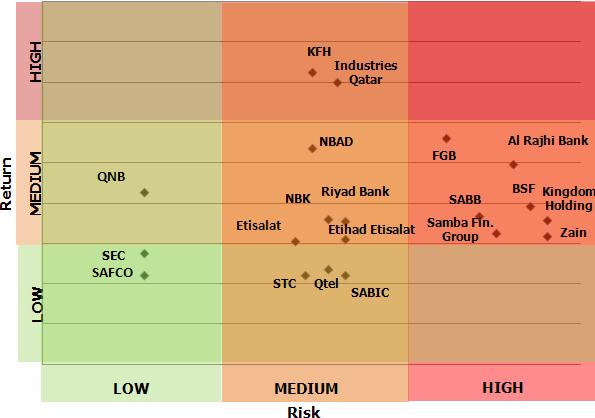_36.jpg)
GCC stock markets were always about large caps; hence, Kuwait Financial Centre “Markaz” has endeavored to take a closer look at the segment through its new report titled “GCC Defensive Bellwether Stocks”.
When looking at the top 20 companies listed in the GCC stock markets (measured by market capitalization), certain themes emerge:
They are dominant (48% of market cap, 23% of total value traded, 61% from KSA, 70% from just two sectors banking and chemicals) and therefore skew the set
They enjoy large government ownerships (averaging 45%) and therefore sap liquidity (turnover velocity averages just 12%) &
Offer high dividend yields (5% on average)
However, the muted market performance during the last few years has seen them not deliver positive shareholder value. Measured in the short-term (last one year), only 3 of the 20 managed to beat their stock market index in terms of performance.
Are they Risky?
As a group, they share a medium to high risk profile measured in terms of standard deviation (ranging from 20% to 54%). Other key risk metrics like average monthly returns, monthly high/low, losing streaks, and drawdown also point to similar trend of medium to high risk. Hence, they would tend to exhibit more of the characteristics of a value stock than a growth stock.
How are they correlated?
Given the lack of market integration, the correlation looks mostly spurious. Otherwise how can you explain the highest positive correlation (95%) between Qatar National Bank and Saudi Arabian Fertilizer Co or highest negative correlation (-71%) between Saudi Telecom and Etihad Etisalat (both Saudi-based telecom companies). Hence, basing portfolio allocations on correlation may be misleading until markets integrate.
The twenty largest GCC stocks have a total market cap of USD 325 bn, spanning four countries and five main industries. The largest stock is Sabic, with 11% of GCC market cap, followed distantly by Al Rajhi Bank at 4%.
Value Traded for the group amounted to USD 59bn as of September 2011, though USD 31bn (53%) of that was accounted for by Sabic followed by Al Rajhi with 8% of total value traded. The average turnover velocity for the group during the period was roughly 12%, relatively low given the high degree of government and institution holding of Large Caps in addition to the overall decline in trading across the region.
The group has an average Dividend Yield of just over 5%, the highest yields coming from the Chemicals and Telecom sectors. Average RoE and RoA came in at 18.6% and 8%, respectively, during the period.
Expected Risk/Return – 2012f

In terms of Expected Risk and Return for the coming year, some patterns emerged:
- The majority of telecoms, regardless of domicile, ranked on the Medium scale in terms of risk; Zain is an exception again here, with a High risk scoring given the largely negative corporate news associated with the firm. Furthermore, Qtel and STC scored low on the expected return front while Zain, Etisalat and Etihad Etisalat have Medium return expectations given declines suffered by the stocks this year (thereby giving upside potential) for Zain and Etisalat while Etihad Etisalat’s expectation comes from its rapid attainment of market share in the Kingdom and high further growth potential.
- As for banks, which make up 50% of the number of companies, the results were far more dispersed;
- Four out of five Saudi banks showed Medium Returns and High Risk except Riyad Bank which scored Medium in terms of both Risk and Return.
- The two UAE banks, NBAD and FGB, both scored in Medium in terms of expected return for 2012, but differed in their Risk. NBAD shows Medium given relatively steady performance while FGB shows High risk potential having spent 6 of the last twelve months in negative territory.
- Kuwait had two banks in the group, NBK and KFH; the former had Medium Risk/Medium Return profile while the latter had a Medium Risk/High Return scoring, due to positive 2012 earnings forecast.
- QNB scored in the Low Risk/Medium Return quadrant; the only bank in the group to do so.
- The region’s petrochemical giants, SABIC and Industries Qatar, both ranked Medium in terms of Risk; Industries Qatar showed a High return expectation while Sabic scored Low given lower earnings expectations based on a slight slow-down in revenue growth.
- The sole Utility stock, Saudi Electricity Company, was ranked on the Low Risk/Low Return scale due to steady, but relatively lower growth potential.
About Kuwait Financial Centre “Markaz”
Kuwait Financial Centre S.A.K. 'Markaz', established in 1974 with total assets under management of over KD 872 million as of September 30th, 2011, is the leading and award winning asset management and investment banking institution in the Arabian Gulf Region. Markaz is listed on the Kuwait Stock Exchange (KSE) since 1997 under ticker Markaz.

